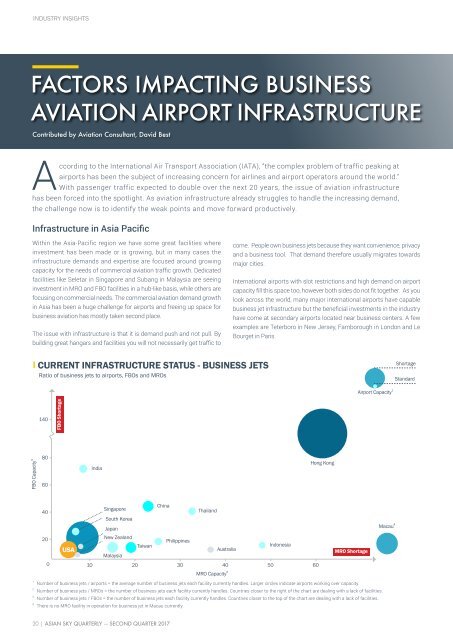ASQ7 EN (20170705)
You also want an ePaper? Increase the reach of your titles
YUMPU automatically turns print PDFs into web optimized ePapers that Google loves.
INDUSTRY INSIGHTS<br />
FACTORS IMPACTING BUSINESS<br />
AVIATION AIRPORT INFRASTRUCTURE<br />
Contributed by Aviation Consultant, David Best<br />
According to the International Air Transport Association (IATA), “the complex problem of traffic peaking at<br />
airports has been the subject of increasing concern for airlines and airport operators around the world.”<br />
With passenger traffic expected to double over the next 20 years, the issue of aviation infrastructure<br />
has been forced into the spotlight. As aviation infrastructure already struggles to handle the increasing demand,<br />
the challenge now is to identify the weak points and move forward productively.<br />
Infrastructure in Asia Pacific<br />
Within the Asia-Pacific region we have some great facilities where<br />
investment has been made or is growing, but in many cases the<br />
infrastructure demands and expertise are focused around growing<br />
capacity for the needs of commercial aviation traffic growth. Dedicated<br />
facilities like Seletar in Singapore and Subang in Malaysia are seeing<br />
investment in MRO and FBO facilities in a hub-like basis, while others are<br />
focusing on commercial needs. The commercial aviation demand growth<br />
in Asia has been a huge challenge for airports and freeing up space for<br />
business aviation has mostly taken second place.<br />
The issue with infrastructure is that it is demand push and not pull. By<br />
building great hangars and facilities you will not necessarily get traffic to<br />
come. People own business jets because they want convenience, privacy<br />
and a business tool. That demand therefore usually migrates towards<br />
major cities.<br />
International airports with slot restrictions and high demand on airport<br />
capacity fill this space too, however both sides do not fit together. As you<br />
look across the world, many major international airports have capable<br />
business jet infrastructure but the beneficial investments in the industry<br />
have come at secondary airports located near business centers. A few<br />
examples are Teterboro in New Jersey, Farnborough in London and Le<br />
Bourget in Paris.<br />
CURR<strong>EN</strong>T INFRASTRUCTURE STATUS - BUSINESS JETS<br />
Ratio of business jets to airports, FBOs and MROs<br />
Shortage<br />
Airport Capacity 1 Standard<br />
140<br />
FBO Shortage<br />
FBO Capacity 3<br />
80<br />
60<br />
India<br />
Hong Kong<br />
40<br />
Singapore<br />
South Korea<br />
Japan<br />
China<br />
Thailand<br />
Macau 4<br />
20<br />
USA<br />
New Zealand<br />
Malaysia<br />
Taiwan<br />
Philippines<br />
Australia<br />
Indonesia<br />
MRO Shortage<br />
0<br />
10 20 30 40 50 60<br />
MRO Capacity 2<br />
1<br />
Number of business jets / airports = the average number of business jets each facility currently handles. Larger circles indicate airports working over capacity.<br />
2<br />
Number of business jets / MROs = the number of business jets each facility currently handles. Countries closer to the right of the chart are dealing with a lack of facilities.<br />
3<br />
4<br />
Number of business jets / FBOs = the number of business jets each facility currently handles. Countries closer to the top of the chart are dealing with a lack of facilities.<br />
There is no MRO facility in operation for business jet in Macau currently.<br />
20 | ASIAN SKY QUARTERLY — SECOND QUARTER 2017

















